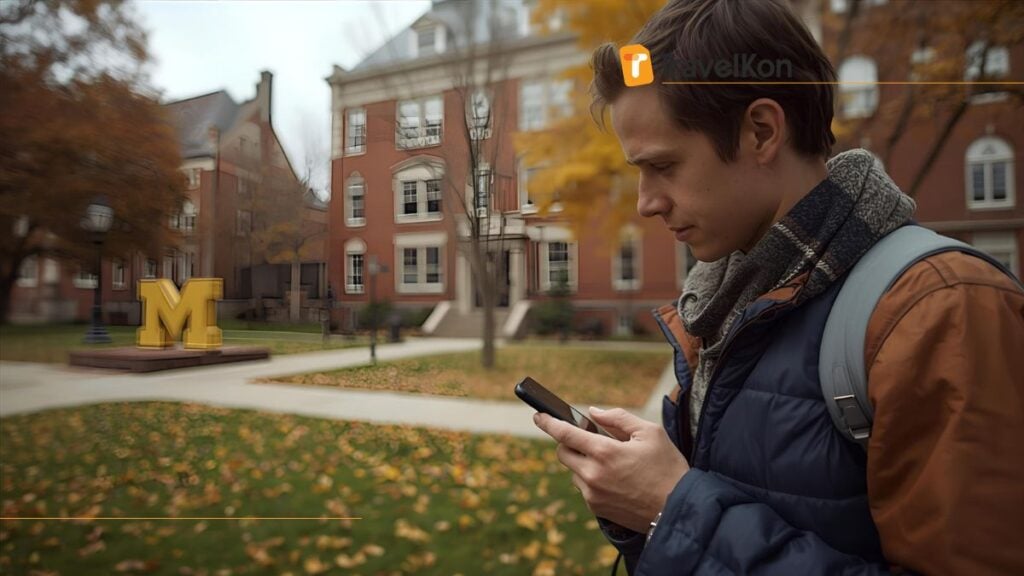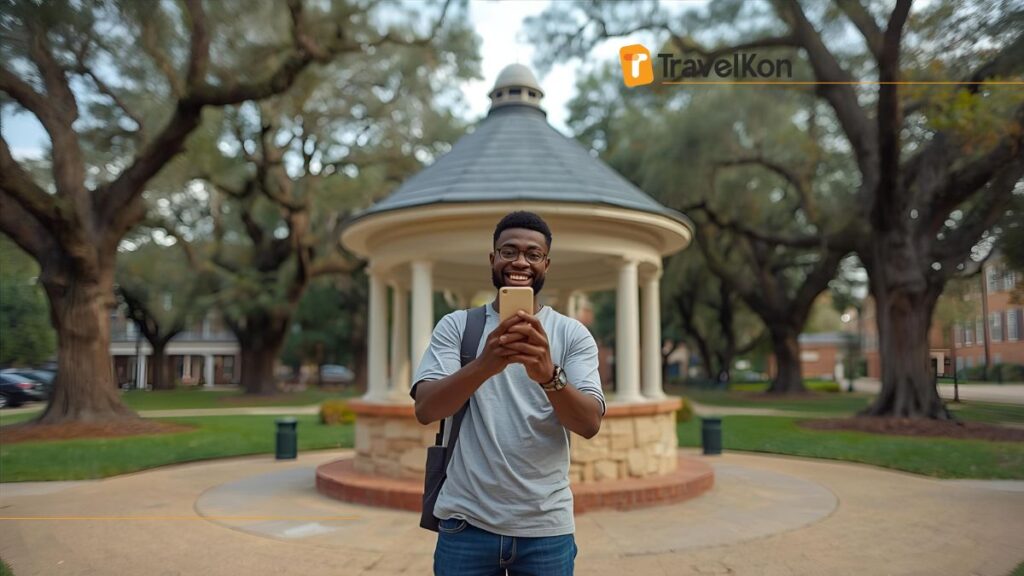Exploring Top US public universities, opens doors to world-class education at accessible costs for international students. American public institutions combine rigorous academic programmes with cutting-edge research facilities and vibrant campus cultures. International students gain invaluable exposure to diverse perspectives whilst building networks that span continents and industries.
Navigating campus visits and university tours requires reliable connectivity for coordinating interviews, accessing campus maps, and staying connected with family. TravelKon’s USA eSIM solutions ensure prospective students remain connected throughout their American university exploration journey without expensive roaming charges.
According to the Institute of International Education, public universities host 68% of international students in the United States. These institutions offer exceptional value through lower tuition rates whilst maintaining comparable academic standards and research opportunities.
Cheapest USA eSIM for Travellers

International students visiting multiple universities across different states need affordable connectivity that doesn’t compromise on quality. Traditional roaming plans quickly become expensive when accessing maps, researching accommodation, and communicating with university admissions offices. Budget-conscious students require cost-effective solutions that maintain reliable service throughout extended campus tours.
TravelKon provides various eSIM options catering to different travel durations and data requirements for university visits. Instant digital activation eliminates the hassle of finding physical stores in unfamiliar cities.
Affordable eSIM options include:
- USA eSIM – Budget-friendly option for students touring universities exclusively within American borders
- USA, Canada, Mexico eSIM – Cost-effective solution for students comparing universities across North American countries
- T-Mobile Unlimited Tri-Country eSIM – Affordable unlimited data perfect for heavy navigation and video calls
- AT&T USA eSIM – Reliable coverage ensuring students stay connected during campus interviews
- AT&T Unlimited Tri-Country eSIM – Comprehensive coverage for extended university exploration trips
- Verizon Unlimited Tri-Country eSIM – Superior rural coverage reaching universities in smaller college towns
These solutions offer transparent pricing without hidden fees or surprise charges that plague traditional roaming services. Students budget accurately for their university tours whilst maintaining constant communication with admission counsellors.
10 Best Public Universities in USA

Which American public universities consistently rank amongst global leaders in education and research? The top public institutions combine academic excellence with affordability, making quality education accessible to talented students worldwide. These universities maintain competitive admission standards whilst offering robust financial aid programmes for international applicants.
Leading public universities include:
- University of California, Berkeley – Renowned for engineering, computer science, and business programmes with Silicon Valley connections
- University of Michigan, Ann Arbor – Comprehensive research powerhouse excelling across humanities, sciences, and professional schools
- University of California, Los Angeles – Premier institution offering excellence in film, medicine, engineering, and performing arts
- University of Virginia – Historic institution combining liberal arts tradition with modern research capabilities
- Georgia Institute of Technology – Engineering and technology leader with exceptional industry partnerships and placement rates
- University of North Carolina, Chapel Hill – Outstanding journalism, public health, and business programmes in picturesque setting
- University of California, San Diego – Cutting-edge research in bioengineering, oceanography, and neuroscience programmes
- University of Illinois, Urbana-Champaign – Engineering powerhouse with strong computer science and agricultural programmes
- University of Wisconsin, Madison – Research excellence across sciences, engineering, and agricultural studies
- University of Washington, Seattle – Leading medical research, computer science, and environmental studies programmes
Each institution offers distinct strengths attracting students with specific academic interests and career goals. These universities provide extensive support services specifically designed for international students including orientation programmes and cultural adjustment workshops.
How Do Public Universities Differ From Private Institutions?

Public universities receive substantial state government funding, enabling them to offer lower tuition rates than private institutions. State support allows these universities to serve larger student populations whilst maintaining quality academic programmes. International students typically pay higher out-of-state tuition rates, though these remain more affordable than comparable private universities.
Private institutions rely primarily on endowments, donations, and tuition revenue for operations. This funding structure often results in smaller class sizes and more individualised attention from professors.
Key differences include:
- Public universities generally host larger, more diverse student bodies reflecting broader demographic representation
- Private institutions often provide more generous financial aid packages though fewer total scholarship opportunities
- Public university campuses typically offer extensive facilities including major sports programmes and research centres
Class sizes at public universities vary significantly between introductory courses and upper-level seminars. International students should evaluate both types based on programme strength rather than institutional category alone.
What Admission Requirements Do Top Public Universities Expect?
Competitive public universities evaluate applications holistically, considering academic performance alongside extracurricular achievements and personal qualities. Strong secondary school records with challenging coursework form the foundation of successful applications. International students must demonstrate English proficiency through TOEFL or IELTS examinations with minimum scores varying by institution.
Standardised testing requirements continue evolving, with many universities adopting test-optional policies post-pandemic. However, competitive scores on SAT or ACT examinations strengthen applications, particularly for merit-based scholarship consideration.
Essential application components include:
- Comprehensive transcripts showing consistent academic performance across all subject areas
- Personal statements revealing character, motivation, and unique perspectives students bring
- Letters of recommendation from teachers highlighting intellectual curiosity and classroom contributions
- Demonstrated leadership through sustained extracurricular involvement rather than superficial participation
- English proficiency scores meeting institutional minimums, typically TOEFL 80-100 or IELTS 6.5-7.5
Application deadlines for international students often occur earlier than domestic deadlines to accommodate visa processing requirements. Universities increasingly value diversity of experience and perspective over purely numerical academic achievements.
How Much Does Studying at Public Universities Actually Cost?
Tuition costs at public universities for international students range from $25,000 to $50,000 annually depending on institution and programme. Out-of-state tuition rates apply to international students, significantly exceeding costs paid by state residents. Living expenses vary dramatically based on university location, with urban campuses substantially more expensive than rural settings.
Students budget $15,000 to $25,000 annually for accommodation, meals, textbooks, and personal expenses. Health insurance requirements add $2,000 to $3,000 annually to total costs.
Cost considerations include:
- Tuition rates increase 3-5% annually, requiring financial planning beyond first-year estimates
- On-campus housing typically costs less than off-campus alternatives during initial years
- Meal plans offer predictable budgeting though cooking independently reduces food expenses
- International student fees cover orientation programmes and ongoing support services
Merit-based scholarships reduce costs for academically exceptional students, with awards ranging from partial tuition waivers to full-ride packages. Many states offer in-state tuition rates to international students after one year of residency.
What Career Opportunities Follow Public University Graduation?
Graduates from top public universities access extensive career networks and recruitment opportunities across industries. Established alumni networks span generations, providing mentorship and professional connections globally. Career services facilitate on-campus recruiting events where major employers interview candidates.
Optional Practical Training allows international students to work in their field for 12 months post-graduation, extending to 36 months for STEM graduates. Strong university reputations open doors with employers seeking talented international perspectives.
Career advantages include:
- Established industry partnerships creating direct pipelines to leading companies
- Internship programmes during academic terms building experience and professional networks
- Career fairs attracting hundreds of employers specifically seeking public university talent
- Alumni mentorship programmes connecting students with successful graduates across industries
Graduate employment rates from top public universities match or exceed private institution outcomes across most disciplines. Many international students leverage American education to return home with enhanced qualifications and global perspectives.



